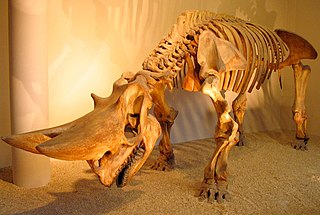
Arsinoitherium is an extinct genus of paenungulate mammals belonging to the extinct order Embrithopoda. It is related to elephants, sirenians, and hyraxes. Arsinoitheres were superficially rhinoceros-like herbivores that lived during the Late Eocene and the Early Oligocene of North Africa from 36 to 30 million years ago, in areas of tropical rainforest and at the margin of mangrove swamps. A species described in 2004, A. giganteum, lived in Ethiopia about 27 million years ago.
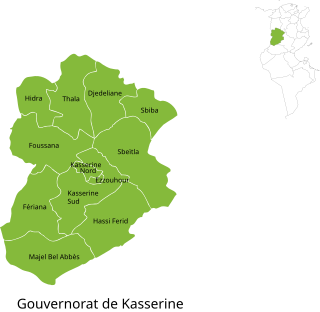
Kasserine Governorate, sometimes spelt Casrein, is one of the twenty-four governorates (provinces) of Tunisia. It is in west-central Tunisia on the frontier with Algeria, wholly north of the true centre line but the area is south or west of the bulk of the population of the country, based on Tunisia's greater northern rainfall. It covers an area of 8,260 km2 and has a population of 468,925 (2023).The capital is Kasserine which is at the foot of Jebel ech Chambi, Tunisia's highest mountain, in turn part of the Dorsal Atlas mountains. The mountain and its associated escarpment form its own national park in the province.

Icaronycteris is an extinct genus of microchiropteran (echolocating) bat that lived in the early Eocene, approximately 52.2 million years ago, making it the earliest known definitive bat. Four exceptionally preserved specimens, among the best preserved bat fossils, are known from the Green River Formation of North America. The best known species is I. index. Fragmentary material from France has also been tentatively placed within Icaronycteris as the second species I. menui. I. sigei is based on well-preserved fragments of dentaries and lower teeth found in Western India. In 2023, the species I. gunnelli also from the Green River Formation was distinguished from I. index, and I. menui and I. sigei were proposed to be removed from the genus due to them not being closely related.
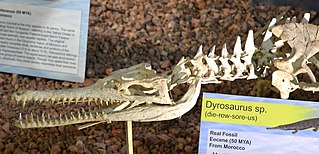
Dyrosaurus is a genus of extinct crocodylomorph that lived during the early Eocene. The name Dyrosaurus comes from sauros (σαῦρος) the Greek for lizard or reptile, and Dyr for Djebel Dyr (mountain) close to where the type species was discovered. It was a large reptile with an estimated body length of 6.5 metres (21 ft).
Witwatia is an extinct genus of giant bat that contained two species which lived in the Al Fayyum in Egypt during the late Eocene and one species which lived in Tunisia during the early Eocene. It is known from a lower jaw and teeth. Three species have been named: the type species W. schlosseri, W. eremicus and W. sigei.

Herpetotheriidae is an extinct family of metatherians, closely related to marsupials. Species of this family are generally reconstructed as terrestrial, and are considered morphologically similar to modern opossums. Fossils of herpetotheriids come from North America, Asia, Europe, Africa, and perhaps South America. The oldest representative is Maastrichtidelphys from the latest Cretaceous (Maastrichtian) of the Netherlands and the youngest member is Amphiperatherium from the Middle Miocene of Europe. The group has been suggested to be paraphyletic, with an analysis of petrosal anatomy finding that North American Herpetotherium was more closely related to marsupials than the European Peratherium and Amphiperatherium.
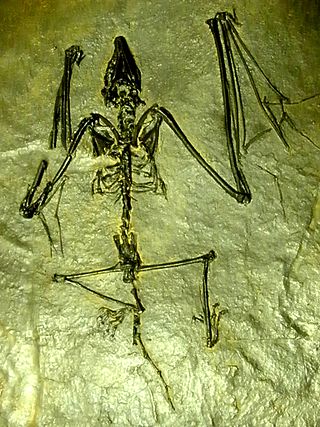
Archaeonycteris is an archaic bat genus whose fossilised remains have been found in Germany, France, England and India.

The Jebel Qatrani Formation is a geologic formation located in the Faiyum Governorate of central Egypt. It is exposed between the Jebel Qatrani escarpment and the Qasr el Sagha escarpment, north of Birket Qarun lake near Faiyum. The formation conformably overlies the Qasr el Sagha Formation and is topped by the Widan el Faras Basalt. The age of the formation has been subject to debate, but the most recent research indicates that it covers both the latest parts of the Eocene and the Early Oligocene, spanning over the boundary between these two time periods.

Archaeonycteridae is a family of extinct bats. It was originally erected by the Swiss naturalist Pierre Revilliod as Archaeonycterididae to hold the genus Archaeonycteris. It was formerly classified under the superfamily Icaronycteroidea (disused) by Kurten and Anderson in 1980. In 2007, the spelling was corrected to Archaeonycteridae and it was reclassified to the unranked clade Microchiropteramorpha by Smith et al.. The family Palaeochiropterygidae was also merged into Archaeonycteridae by Kurten and Anderson, but modern authorities specializing in bat fossils maintain the distinction between the two.
Azibiidae is an extinct family of fossil primate from the late early or early middle Eocene from the Glib Zegdou Formation in the Gour Lazib area of Algeria. They are thought to be related to the living toothcombed primates, the lemurs and lorisoids, although paleoanthropologists such as Marc Godinot have argued that they may be early simians. It includes the genera Azibius and Algeripithecus, the latter of which was originally considered the oldest known simian, not a strepsirrhine.
Djebelemur is an extinct genus of early strepsirrhine primate from the late early or early middle Eocene period from the Chambi locality in Tunisia. Although they probably lacked a toothcomb, a specialized dental structure found in living lemuriforms, they are thought to be a related stem group. The one recognized species, Djebelemur martinezi, was very small, approximately 100 g (3.5 oz).
Philisidae is an extinct family of bats of the suborder Microchiroptera that lived between the Eocene to the Late Miocene in the continent of Africa.

Stagodontidae is an extinct family of carnivorous metatherian mammals that inhabited North America and Europe during the late Cretaceous, and possibly to the Eocene in South America.

Necromantis is an extinct genus of bat that lived during the Eocene. Its fossils are found in the Quercy Phosphorites Formation of France and the Djebel Chambi in Tunisia. Specimens of Necromantis are notable for their large size and specialization towards a predatory lifestyle.
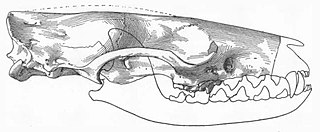
Viverravus is an extinct genus of placental mammals from extinct subfamily Viverravinae within extinct family Viverravidae, that lived in North America, Europe and Asia from the middle Paleocene to middle Eocene.
Propotto is an extinct, monotypic genus of early strepsirrhine primate from the early Miocene of Kenya. It contains one described species, Propotto leakeyi. Although long considered a pteropodid fruit-eating bat after spending a brief sojourn as a prehistoric relative of lorises, recent research shows it to be an extinct relative of the aye-aye.
Wyonycteris is a genus of small mammals that existed in the late Paleocene and early Eocene epochs. The type species is Wyonycteris chalix, which lived in Wyoming during the Clarkforkian North American Land Mammal Age of the Paleocene and was originally proposed to be an early form of insectivorous bat. Later re-examination of the material has put this alliance in doubt, and the genus has instead been proposed as belonging to the subfamily Placentidentinae, within the family Nyctitheriidae. Similar fossil material of the same time period found in Europe was later discovered and described as new species, Wyonycteris richardi.

Noctilionoidea is a superfamily of bats containing seven families: Thyropteridae, Furipteridae, Noctilionidae, Mormoopidae, Phyllostomidae, Myzopodidae, and Mystacinidae.
Chambiortyx is a genus of Galliformes bird. It is known from a fossil of the early Eocene of Tunisia.










